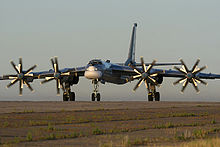 Photo fromhttps://en.wikipedia.org/wiki/Tupolev_Tu-95
Photo fromhttps://en.wikipedia.org/wiki/Tupolev_Tu-95
I have spent quality time with the air force and as the IAF had a Russian connection, I was lucky to visit Russia many times. During my visits to Russia I and my fellow colleagues were treated with utmost respect and the Soviets genuinely thought of India as a friend.
One of the aircraft that impressed me was the Tu-95 which gave the code name Bear by the NATO powers. The history of the plane makes interesting reading. In the early fifties of the last century, despite having the Atomic bomb the Russians did not have a proper delivery system to attack America. The cold war was in full swing and the Russians desperately needed a deterrence.Josef Stalin had a meeting with the designer AndrieTupolev and the result was the Bear.Andrie Tupelov was one of the engineering greats of Russia in the field of aviation and the lon rane aircraft are part of his contribution to the history of aviation.
The plane first flew in 1952 and had a range of 9000 miles. All credit to Andrei Tupolev who spent eons of time on the drawing board and the wind tunnel tests. TheBear was a 4 engine turbo- prop plane. It was powered by the Kuznetsov engines which at that time were the biggest and most powerful engines in the aviation world. The plane had tremendous endurance and large bomb bays as in those days, the Atomic bombs were large gravity falling bombs. With this plane, the Russians for the first time had a strategic bomber that could fly to the heartland of the USA.
The Russians churned out a few more versions and one of them were theTU-114 which was also sold to the Indian navy for sea surveillance. The Russian AF ordered substantial numbers of these strategic bombers. As on date more than 59 of these strategic long-range bombers are still in service with the RAF.As per the vision document of the Russian AF, these planes will not be retired till 2040. In other words, the planes will remain part of the strike command of the strategic air force till 2040.
The plane looks like a blast from the past. It has a speed of 710 mph and the engines make a pounding sound. Once the plane revs up and goes into a dive at full throttle the sound is so strong that even a submarine submerged can hear the approach of the bomber . Never the less, despite this relative drawback, the plane is a great platform for offensive weapons. It can also carry cruise missiles and launch them against an enemy at some distance from the target. This makes it a great weapons platform. The plane is the pride of the Air Force and Russians feel mighty proud to have such a lethal strategic bomber.
I first saw this behemoth in the Russian airbase and its size awed me. I had not seen such a large plane. I wanted to take some photographs, but it was not allowed. Subsequently, I did ride in the plane as a passenger. With the permission of the senior captain on board, I had an entry into the cockpit and was struck by the maze of electronic equipment displayed.It had ECM and ECCM on board. The plane could carry atomic bombs and has been the main strategic bomber of the Russian air force for over 5 decades. This points to its technical excellence and airworthiness.
The TU-95 is now getting a little dated and recently two crashes occurred in Siberia. This sent alarm bells ringing and the entire fleet was grounded, but after a technical inspection, the plane is back in harness. I traveled on the plane from Moscow to Vladivostok in the east, a distance of almost 5000 miles and the flight was smooth. But at times the noise was a bit too much and so we were given earphones. I always wondered why the IAF did not ask the Russians for this plane as it would have been a great deterrence to China with its range and Beijing and entire Manchuria would have been in the range of the IAF. But strange are the ways of the politicians and one wonders what happened, for the Russians did give the TU-114 the long-range maritime version of the plane to the Indian navy and it even now soars over the Arabian Sea.
During the height of the cold war, the TU-95 was a force multiplier. It could carry cruise missiles with nuclear warheads and the planes often approached the California coast. They were a potent threat to the US and the USAF often scrambled jet fighters to intercept these bombers. The USSR at that time used this plane as a deterrence and with its awesome range it kept the Soviet response to the US bases around the Soviet union at strength five.
After the end of the cold war, the Russians did not scrap these planes, but upgraded them and now they will serve with the Russian Air force till 2040. One reason for this is, that the Russians have not yet developed an alternate strategic bomber of comparable range. The Bear thus still carries the Russian flag to the far corners of the world. Even now sometimes Putin orders these planes and they approach the California coast, a gentle reminder that Russia remains a great power, though the erstwhile Soviet Union is part of history.
The Russians feel a tremendous sense of pride in this plane, which gives the Russians something to crow about as the USAF has no comparable plane of this range and endurance.